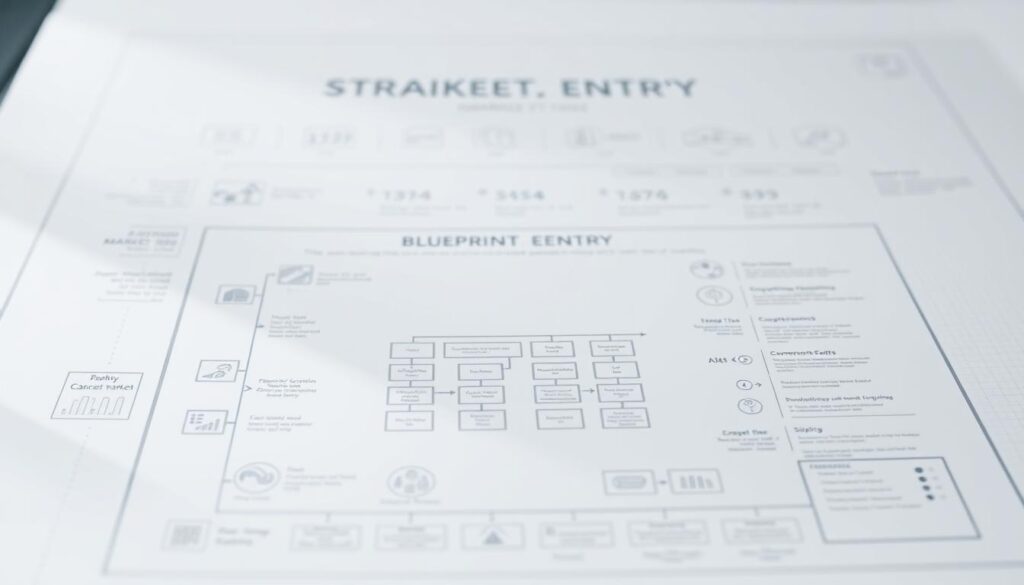Launching products in today’s dynamic business environment demands more than ambition—it requires structured methodologies that align teams and anticipate challenges. Organizations must balance consumer behavior shifts, digital disruptions, and competitive pressures while coordinating activities across departments. This complexity underscores the need for actionable roadmaps that transform ideas into measurable outcomes.
Effective execution relies on data-driven insights from market research and competitor analysis. These insights inform positioning strategies while identifying resource gaps. Cross-functional collaboration becomes critical when synchronizing timelines between marketing, sales, and operations teams—a process demanding clarity and accountability.
Agile frameworks help businesses adapt to emerging trends without sacrificing strategic focus. By integrating risk assessment and performance metrics, leaders can refine approaches in real time. This adaptability separates thriving enterprises from those struggling to gain traction in saturated markets.
Key Takeaways
- Structured methodologies reduce risks during product launches
- Cross-department coordination ensures aligned execution
- Consumer behavior analysis drives competitive positioning
- Agile frameworks enable rapid response to market shifts
- Performance metrics guide continuous strategy refinement
Understanding the Go to Market Landscape
Navigating modern business challenges requires more than intuition—it demands structured planning rooted in consumer insights. A well-designed approach acts as a compass, guiding teams through competitive terrain while aligning priorities across departments.
What Is a Go to Market Strategy?
This strategy answers four critical questions: Which problem does the product solve? Who faces this challenge? Where will solutions gain traction? and How will teams deliver value? It transforms abstract ideas into actionable steps, ensuring resources target high-impact opportunities. For example, one tech firm increased launch success rates by 40% after mapping customer pain points to product features.
The Importance of a Strategic Market Process
Complex launches thrive on processes that synchronize research, positioning, and execution. Industry leaders like Adobe attribute 30% faster time-to-market to standardized frameworks. These systems create accountability through measurable milestones while allowing flexibility to adapt pricing or messaging as conditions shift.
“The difference between chaos and clarity lies in documenting workflows early,” notes a Gartner analyst. “Teams that outline decision rights and escalation paths recover twice as fast from setbacks.”
By anticipating risks and establishing feedback loops, organizations maintain momentum even when facing supply chain disruptions or shifting buyer preferences. This proactive stance turns potential obstacles into opportunities for refinement.
Developing a Comprehensive Market Strategy
Crafting a market strategy that delivers results begins with precise audience insights and competitor intelligence. Organizations must connect customer priorities to operational capabilities while identifying untapped opportunities competitors overlook.
Identifying Your Target Audience and Market Needs
Professional researchers recommend analyzing four dimensions to define ideal customers: demographics (age, income), psychographics (values, lifestyle), behavioral patterns (purchasing habits), and pain points. For instance, a SaaS company discovered 22% higher conversions after tailoring messaging to address workflow frustrations identified through user interviews.
Quantitative data from surveys and analytics reveals what customers do, while qualitative feedback explains why. This dual approach helps companies refine product service features and prioritize roadmap updates that align with evolving expectations.
Conducting Competitive Analysis
Strategic analysts advocate examining three layers of competition: direct rivals, substitute solutions, and emerging disruptors. Tools like SWOT analysis expose vulnerabilities in pricing strategies or customer engagement models. One beverage brand gained 15% market share by targeting regions where competitors underinvested in distribution networks.
“True competitive advantage emerges when you solve problems others ignore,” observes a Forrester Research strategist. “Map your strengths to market gaps competitors can’t easily replicate.”
Regular monitoring of regulatory changes and technological shifts ensures strategies remain relevant. Companies that update their market strategy quarterly report 34% faster response times to industry disruptions compared to annual planners.
Building Buyer Personas and Crafting Messaging
Effective communication starts with deep insights into who your customers are and what drives their decisions. By transforming raw data into relatable profiles, teams can design strategies that resonate with specific audience segments. This approach bridges the gap between organizational goals and consumer expectations.

Creating Detailed Buyer Personas
Buyer personas combine demographics, behavioral patterns, and psychographics to humanize target groups. For example, a SaaS company boosted conversions by 22% after mapping IT managers’ workflow challenges to product updates. Key attributes include:
| Attribute | Description | Strategic Impact |
|---|---|---|
| Industry Role | Job responsibilities and decision-making authority | Tailors feature prioritization |
| Pain Points | Daily challenges affecting productivity | Shapes solution positioning |
| Media Preferences | Platforms used for professional research | Guides content distribution |
Tailoring Messaging to Address Pain Points
Strategic messaging transforms product capabilities into compelling narratives. When a fintech firm aligned its campaigns with CFOs’ regulatory concerns, lead quality improved by 18%. The most effective communications:
- Use language mirroring audience vocabulary
- Highlight outcomes over technical specifications
- Address unspoken fears about implementation
“Persona-driven content achieves 3x higher engagement because it speaks to lived experiences rather than hypothetical needs,” explains a HubSpot strategist.
Continuous refinement ensures messaging stays relevant as customers evolve. Quarterly persona audits help organizations adapt to shifting priorities in competitive landscapes.
Leveraging the go to market site map for Planning
Transforming strategic objectives into actionable steps requires tools that bridge vision and execution. A well-structured framework clarifies priorities while synchronizing efforts across departments, turning fragmented tasks into cohesive workflows.
Visualizing Your Roadmap and Timelines
Professionals rely on visual tools like Gantt charts to map dependencies and deadlines. These diagrams highlight critical paths, showing how delays in one task ripple through others. For example, a healthcare tech company reduced launch delays by 28% after identifying resource conflicts early through timeline visualization.
Setting Milestones and Coordinating Teams
Milestones act as progress checkpoints, ensuring alignment between marketing, sales, and product groups. Effective coordination involves:
- Defining measurable outcomes for each phase
- Scheduling weekly cross-functional reviews
- Using shared dashboards to track responsibilities
“Teams that document dependencies upfront recover 45% faster from setbacks,” states a McKinsey operations lead. “Visibility prevents assumptions from derailing timelines.”
Integrating risk buffers into schedules allows organizations to adapt without sacrificing quality. This approach keeps initiatives on track even when external factors shift.
Aligning Cross-Functional Team Efforts
Successful product launches hinge on team members from different departments working as a unified force. Marketing specialists, sales representatives, and product managers must align their efforts to create seamless customer experiences. This coordination prevents duplicated work and ensures every action supports strategic goals.
Establishing Collaboration Between Marketing and Sales
Breaking down silos starts with defining how teams interact during launch phases. Regular sync meetings and shared dashboards keep both groups informed about campaign performance and lead quality. For example, companies using strategic alignment frameworks report 27% faster resolution of interdepartmental conflicts.
| Collaboration Strategy | Implementation Method | Impact |
|---|---|---|
| Role Clarity | Documented responsibility matrices | Reduces task overlap by 41% |
| Shared Metrics | Joint KPIs for lead conversion | Improves handoff efficiency by 33% |
| Feedback Loops | Bi-weekly progress reviews | Accelerates course corrections by 19% |
Effective collaboration extends beyond initial planning. Sales teams provide real-time insights about customer objections, allowing marketers to refine messaging. Meanwhile, product team members share feature updates that help sales reps address technical questions confidently.
“Alignment isn’t about agreement—it’s about creating systems where diverse expertise complements rather than conflicts,” notes a Deloitte organizational strategist.
Leaders who invest in conflict resolution protocols and recognition programs maintain efforts during high-pressure periods. These practices ensure all members feel valued while driving toward measurable outcomes.
Integrating Product Positioning and Pricing Strategy
Aligning product positioning with pricing requires precision. These elements work together to shape customer perceptions and profitability. Companies that master this balance create differentiated offerings customers willingly pay for.

Defining Your Unique Selling Proposition
A Unique Selling Proposition (USP) answers why customers should choose your solution. It combines tangible benefits with emotional appeal. For example, a cybersecurity firm increased conversions by 18% by emphasizing real-time threat detection over generic “secure platform” claims.
| Positioning Factor | Competitor Analysis Focus | Customer Impact |
|---|---|---|
| Feature Superiority | Technical specifications comparison | Justifies premium pricing |
| Service Differentiation | Support response time benchmarks | Builds long-term loyalty |
| Niche Expertise | Industry-specific use cases | Reduces price sensitivity |
Establishing Competitive Pricing Models
Pricing strategies must reflect both value delivered and market realities. Value-based models work best for innovative products, while penetration pricing accelerates market strategy adoption. One SaaS company boosted revenue by 29% after switching from cost-plus to tiered pricing aligned with user outcomes.
Three key considerations for pricing:
- Customer willingness-to-pay across segments
- Competitor price floors and ceilings
- Profit margin requirements
“Great pricing feels fair to buyers and profitable for sellers. Achieve this through continuous value validation, not guesswork,” advises a Bain & Company pricing specialist.
Monthly price audits help maintain alignment as markets evolve. Teams using dynamic pricing tools report 22% faster response to competitive moves compared to static models.
Mapping the Buyer’s Journey for Success
Businesses thrive when they map each step customers take toward purchasing decisions. This process reveals how awareness evolves into consideration and final choices. Aligning touchpoints with these stages creates smoother experiences that build trust and drive action.
Understanding the Funnel: Awareness, Consideration, and Decision
Every customer progresses through three phases when solving problems. In the awareness stage, they research symptoms and potential solutions. Consideration involves comparing options, while decision-making focuses on selecting the best product service for their needs.
| Stage | Customer Focus | Content Strategy | Business Goal |
|---|---|---|---|
| Awareness | Identifying pain points | Educational blogs, infographics | Establish expertise |
| Consideration | Evaluating alternatives | Case studies, comparison guides | Differentiate offerings |
| Decision | Risk mitigation | Free trials, testimonials | Close sales |
Mapping these phases helps teams identify gaps in market strategy. For example, one software firm reduced cart abandonment by 19% after adding demo videos for hesitant buyers. Emotional triggers like fear of inefficiency or desire for status often influence progression between stages.
“Journey mapping isn’t a one-time task—it’s a living process that adapts as customer expectations shift,” says a Forrester CX analyst. “Quarterly audits prevent strategies from becoming outdated.”
Effective campaigns address specific concerns at each phase without overwhelming audiences. By analyzing drop-off points, companies refine messaging and remove friction, creating cohesive experiences that guide decisions naturally.
Implementing Effective Sales and Marketing Tactics
Strategic synergy between outreach methods and closing techniques fuels revenue pipelines. Teams must align channel selection with audience behavior while matching sales approaches to buying preferences. This coordination turns fragmented efforts into cohesive conversion engines.
Choosing the Right Marketing Channels
Professional strategists prioritize platforms where their audience actively researches solutions. A marketing strategy combining social media and SEO content outperforms single-channel efforts by 37% in lead generation. Key considerations include:
| Audience Type | Preferred Channels | Content Format |
|---|---|---|
| Millennial Buyers | Instagram, TikTok | Short videos |
| Enterprise Decision-Makers | LinkedIn, Email | Whitepapers |
| Technical Specialists | Blogs, Webinars | Case studies |
Paid search ads work best for immediate needs, while educational blogs nurture long-term trust. Companies using comprehensive market strategy frameworks report 29% higher ROI through channel optimization.
Leveraging Sales Strategies to Drive Conversions
High-performing teams match their sales model to customer expectations. Field sales excel in complex enterprise deals, while self-service platforms suit transactional purchases. Four proven approaches:
| Model | Focus | Team Structure |
|---|---|---|
| Inside Sales | Relationship nurturing | Remote specialists |
| Channel Partners | Market expansion | Third-party networks |
| Hybrid Approach | Scalable personalization | AI + human teams |
“The best sales strategies feel consultative, not transactional. Train teams to diagnose needs before prescribing solutions,” advises a HubSpot revenue leader.
Continuous A/B testing of pricing pages and follow-up sequences helps refine tactics. Organizations that update their sales strategies quarterly achieve 19% faster conversion rates than annual planners.
Analyzing Data and Adjusting Strategies
Informed decision-making separates thriving organizations from reactive competitors. Modern market strategy relies on continuous data analysis to validate assumptions and uncover hidden opportunities. This approach transforms raw numbers into actionable intelligence that drives iterative improvements.
Measuring KPIs and Performance Metrics
Professional teams track metrics reflecting strategic goals, from lead generation rates to customer retention costs. A SaaS company improved renewal rates by 17% after correlating onboarding completion with long-term satisfaction. Essential KPIs include:
- Campaign ROI across channels
- Sales cycle duration per segment
- Feature adoption patterns
Dashboards displaying real-time data enable swift management interventions. Combining quantitative metrics with customer feedback creates a holistic view of strategies effectiveness.
Refining Your Process Based on Feedback
Agile organizations treat their market process as evolving frameworks rather than fixed plans. Quarterly reviews comparing results against goals highlight necessary adjustments. One retailer reduced inventory waste by 29% after aligning procurement with demand forecasting insights.
Effective refinement involves three steps: analyzing trends, testing hypotheses, and scaling successful tactics. Teams that document lessons learned accelerate future strategies while minimizing repeated errors.
FAQ
What defines an effective go-to-market strategy?
An effective strategy combines market analysis, product positioning, and cross-functional alignment. It requires clear goals, audience insights, and measurable milestones to guide product launches while addressing competitive challenges.
How do buyer personas improve market strategies?
Detailed personas clarify customer pain points, decision-making criteria, and communication preferences. This enables teams to tailor messaging, refine pricing models, and select marketing channels that resonate with specific buyer segments.
Why is competitive analysis critical for market planning?
Analyzing competitors reveals gaps in offerings, pricing advantages, and unmet customer needs. These insights help differentiate products, strengthen value propositions, and inform targeted campaigns that outperform rival solutions.
How does a go-to-market site map enhance execution?
The visual roadmap coordinates timelines, resources, and team responsibilities. It aligns departments by mapping dependencies between product launches, marketing campaigns, and sales enablement activities to maintain momentum.
What metrics matter most when evaluating success?
Key performance indicators include conversion rates, customer acquisition costs, pipeline velocity, and market share growth. Teams should also track engagement metrics across channels and customer satisfaction scores post-launch.
How should pricing strategy align with positioning?
Pricing models must reflect the product’s perceived value and competitive differentiation. Premium offerings justify higher costs through exclusive features, while value-based pricing emphasizes cost savings or ROI for budget-conscious buyers.
What prevents cross-functional alignment failures?
Regular strategy reviews, shared KPIs, and collaborative tools maintain cohesion. Marketing and sales teams should co-create content and lead handoff processes, while product teams share roadmap updates impacting campaign timing.
When should companies revise their market approach?
Strategy adjustments become necessary when facing shifting customer demands, new competitors, or underperforming campaigns. Continuous feedback loops from sales data and customer interviews help identify needed pivots early.



